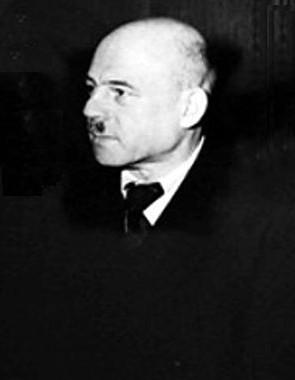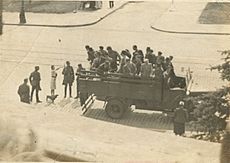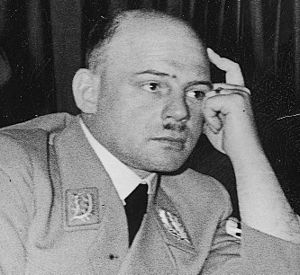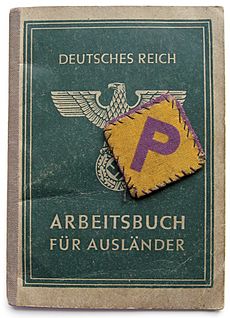Fritz Sauckel facts for kids
Quick facts for kids
Fritz Sauckel
|
|
|---|---|

Sauckel at the Nuremberg trials
|
|
| General Plenipotentiary for Labour Deployment | |
| In office 21 March 1942 – 8 May 1945 |
|
| Appointed by | Adolf Hitler |
| Preceded by | Position created |
| Succeeded by | Position abolished |
| Gauleiter of Gau Thuringia | |
| In office 30 September 1927 – 8 May 1945 |
|
| Appointed by | Adolf Hitler |
| Preceded by | Artur Dinter |
| Succeeded by | Position abolished |
| Reichsstatthalter of Thuringia | |
| In office 5 May 1933 – 8 May 1945 |
|
| Prime Minister | Willy Marschler |
| Preceded by | Position created |
| Succeeded by | Position abolished |
| Minister-President of Thuringia | |
| In office 26 August 1932 – 8 May 1933 |
|
| Preceded by | Erwin Baum |
| Succeeded by | Willy Marschler |
| Acting Reichsstatthalter of the Free State of Anhalt |
|
| In office 29 November 1935 – 19 April 1937 |
|
| Prime Minister | Alfred Freyberg Rudolf Jordan |
| Preceded by | Wilhelm Friedrich Loeper |
| Succeeded by | Rudolf Jordan |
| Acting Reichsstatthalter of the Free State of Brunswick |
|
| In office 29 November 1935 – 19 April 1937 |
|
| Prime Minister | Dietrich Klagges |
| Preceded by | Wilhelm Loeper |
| Succeeded by | Rudolf Jordan |
| Personal details | |
| Born | 27 October 1894 Haßfurt, Kingdom of Bavaria, German Empire |
| Died | 16 October 1946 (aged 51) Nuremberg Prison, Nuremberg, Allied-occupied Germany |
| Cause of death | Execution by hanging |
| Political party | Nazi Party |
| Spouse | Elisabeth Wetzel |
| Children | 10 |
| Occupation | Merchant sailor |
| Criminal conviction | |
| Criminal status | Executed |
| Conviction(s) | War crimes Crimes against humanity |
| Trial | Nuremberg trials |
| Criminal penalty | Death |
Ernst Friedrich Christoph "Fritz" Sauckel (born October 27, 1894 – died October 16, 1946) was a German Nazi politician. He was the Gauleiter (a regional leader) of Gau Thuringia from 1927. From March 1942 until the end of World War II, he was the General Plenipotentiary for Labour Deployment (Arbeitseinsatz). This role meant he was in charge of finding and organizing workers for Germany. After the war, Sauckel was one of 24 people tried at the Nuremberg Trials. He was found guilty of war crimes and crimes against humanity, sentenced to death, and executed.
Contents
Early Life and Career
Fritz Sauckel was born in Haßfurt, a town in what was then the Kingdom of Bavaria. He was the only child of a postman and a seamstress. He went to school in his hometown and later in Schweinfurt. However, he left school in 1909 when he was 15 because his mother became ill.
Life at Sea
At 15, Sauckel began working as a sailor in the merchant marine for Norway and Sweden. He started as a cabin boy on a three-masted schooner. He sailed around the world, eventually becoming an able seaman. When World War I began in 1914, he was on a German ship heading to Australia. The ship was captured by French forces, and Sauckel was held as a prisoner in France from August 1914 until October 1919. During his time as a prisoner, he studied subjects like mathematics, languages, and economics.
Returning to Germany
After being released, Sauckel went back to Germany. For a few years, he worked in a factory in Schweinfurt as an apprentice locksmith and toolmaker. In 1919, he joined the Deutschvölkischer Schutz- und Trutzbund, a large group in Germany that was against Jewish people. He managed their local office in Lower Franconia until 1921. Later, he moved to Thuringia and studied engineering from 1922 to 1923, but he was expelled because of his political activities.
Joining the Nazi Party
Sauckel joined the Nazi Party (NSDAP) in January 1923. He helped start a local group in Ilmenau and became its leader. He also joined the SA, which was the party's private army. In November 1923, he planned a "March on Berlin" with about 80 followers. This was meant to happen at the same time as Adolf Hitler's Beer Hall Putsch in Munich. However, Sauckel and 22 of his followers were arrested before their march could begin.
Even though the Nazi Party was temporarily banned after the failed putsch, Sauckel continued his political work. He started a right-wing group and gave speeches. He also helped create a group in Thuringia that was secretly linked to the SA. In 1924, he became the publisher of a small newspaper in Ilmenau. This newspaper later merged with another and became the official newspaper for the Nazi Party in Thuringia, called Der Nationalsozialist. Sauckel was its editor from 1927 until 1945. Because of his early involvement, Hitler saw him as an "old fighter" and remained loyal to him. In 1924, he married Elisabeth Wetzel, and they had ten children.
Rise in Thuringia
After the Nazi Party was allowed again, Sauckel became the business manager for the Nazi region of Gau Thuringia in March 1925. He officially rejoined the party in April. In February 1927, he was also made the Deputy Gauleiter and was in charge of personnel. Sauckel became the main Gauleiter of Thuringia on September 30, 1927, and he held this position until the end of the Nazi regime.
In December 1929, Sauckel was elected to the Landtag of Thuringia (the state parliament). The Nazis had six members, and they held the balance of power between other parties. In January 1930, a new government was formed in Thuringia that included Nazi ministers for the first time in Germany. Sauckel became the leader of the Nazi group in the parliament. After the election in July 1932, the Nazis won 42.5% of the votes. Sauckel then became the leading Minister of State (like a Minister-President) and the interior minister. This gave him control over the state police.
New Roles in the Nazi Government
After Hitler became Chancellor of Germany in January 1933, Sauckel was appointed to a new role called Reichsstatthalter (Reich Governor) of Thuringia on May 5, 1933. He kept this job until May 1945. This new position helped the central government control the states more closely. On May 8, he left the Thuringian cabinet.
On September 9, 1934, Sauckel joined the SS as an SS-Gruppenführer (a high rank) after being invited by Heinrich Himmler. He was also given an honorary rank in the SA in November 1937. When Wilhelm Friedrich Loeper died, Sauckel took over his role as acting Reichsstatthalter for both Anhalt and Brunswick from November 1935 to April 1937. In January 1937, Sauckel was put in charge of the main office for the Four Year Plan in Thuringia, which aimed to prepare Germany for war.
World War II Responsibilities
When World War II started on September 1, 1939, Sauckel was named Reich Defense Commissioner for a large military district. His job was to oversee civil defense, including air raid protection and evacuations. He also controlled the war economy, managed rationing, and tried to stop the black market. In November 1942, his role as Commissioner was limited to just his region of Thuringia. He was promoted to honorary SS-Obergruppenführer in January 1942 and received the Golden Party Badge, a special award for early Nazi Party members.
General Plenipotentiary for Labour Deployment
On March 21, 1942, Sauckel was given the job he is most remembered for: General Plenipotentiary for Labour Deployment (Generalbevollmächtigter für den Arbeitseinsatz). He was recommended for this role by Martin Bormann.
Sauckel worked under Hermann Göring to find and assign workers for German factories and farms. As the war continued, Germany needed more and more workers. Hitler gave Sauckel special powers in September 1942 to get workers from the areas Germany had taken over. Sauckel's agents could give orders to military and civilian leaders to make sure enough workers were supplied.
Most of the workers came from Eastern Europe, especially Poland and the Soviet Union. The methods used to get these workers were very harsh. The Army was sometimes used to force local people to leave their homes and go to Germany. Of about five million foreign workers brought to Germany, only around 200,000 came willingly.

Working conditions for these forced laborers were extremely difficult, and discipline was very strict. Many were not paid and were given very little food, just enough to barely survive. This type of forced labor was used in many German industries, including coal mining, steel production, and making weapons. The number of forced laborers grew throughout the war. It is estimated that over 12 million such laborers were forcibly brought to Germany to work.
End of the War
In July 1944, Sauckel was named Oberpräsident (Chief President) of the Erfurt region, which became part of Thuringia. In September 1944, he became the leader of the Volkssturm (a home guard militia) in his region. On October 27, 1944, he received a large cash award for his 50th birthday and his work for Germany. On April 10, 1945, after telling his Volkssturm forces to fight the approaching American Army, Sauckel fled the city of Weimar by car. He was arrested in Salzburg by the US Army on May 12, 1945. He was then held in different prisons, eventually ending up in Nuremberg.
Trial and Execution
On November 20, 1945, Sauckel was put on trial before the International Military Tribunal at the Nuremberg trials. He was accused of serious crimes related to the war. He defended his work, saying it was about organizing labor and not about exploiting people. He denied that it was slave labor or that people were intentionally worked to death.
Sauckel's lawyer tried to show him as someone who cared about the working class. His lawyer argued that Sauckel simply met the demands for workers from others, like Albert Speer, who was in charge of armaments. However, the court decided that Sauckel was directly responsible for his role as General Plenipotentiary for Labour Deployment.
Sauckel was found guilty of war crimes and crimes against humanity. He was executed at Nuremberg Prison on October 16, 1946, just 11 days before his 52nd birthday. His body, along with those of other executed men, was cremated, and the ashes were scattered in the river Isar.
See also
 In Spanish: Fritz Sauckel para niños
In Spanish: Fritz Sauckel para niños
- Forced labour in Germany during World War II
- Eastern worker
- List SS-Obergruppenführer
- Service du travail obligatoire
- SS Main Economic and Administrative Office



